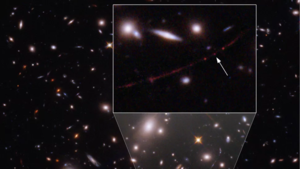Earendel: Difference between revisions
George Swan (talk | contribs) (add references) |
George Swan (talk | contribs) (more details) |
||
| Line 3: | Line 3: | ||
On March 30, 2022, Astronomers using the [[Hubble Space Telescope]] published a paper in ''[[Nature (journal)|Nature]]'', announcing they had found a star they dubbed '''Earendel''' that was 12.9 billion light-years from [[Planet Earth]].<ref name=Space2022-03-30/><ref name=Forbes2022-03-30/> At 12.9 billion light years it would be not only the most distant star yet detected, but also the oldest. | On March 30, 2022, Astronomers using the [[Hubble Space Telescope]] published a paper in ''[[Nature (journal)|Nature]]'', announcing they had found a star they dubbed '''Earendel''' that was 12.9 billion light-years from [[Planet Earth]].<ref name=Space2022-03-30/><ref name=Forbes2022-03-30/> At 12.9 billion light years it would be not only the most distant star yet detected, but also the oldest. | ||
Detection of the star was possible because it was at the focus of a [[Gravitational lens]].<ref name=Space2022-03-30/> | Detection of the star was possible because it was at the focus of a [[Gravitational lens]].<ref name=Space2022-03-30/> ''[[Forbes magazine]]'' reported that the star was detected during the work of the [[Reionization Lensing Cluster Survey]] (RELICS) Program.<ref name=Forbes2022-03-30/> RELICS job was to find distant galaxies worthy of further study by the new [[James Webb Space Telescope]]. | ||
The official designation is ''WHL0137-LS'', and it is at least 50 times the mass of [[Sol]], our sun, and on the order of a million times as bright. The unofficial name, Earendel, is a word from the [[Old English]] language, meaning "first light", as this star shone within the first billion years of our Universe. | The official designation is ''WHL0137-LS'', and it is at least 50 times the mass of [[Sol]], our sun, and on the order of a million times as bright. The unofficial name, Earendel, is a word from the [[Old English]] language, meaning "first light", as this star shone within the first billion years of our Universe. | ||
Revision as of 12:27, 30 March 2022

On March 30, 2022, Astronomers using the Hubble Space Telescope published a paper in Nature, announcing they had found a star they dubbed Earendel that was 12.9 billion light-years from Planet Earth.[1][2] At 12.9 billion light years it would be not only the most distant star yet detected, but also the oldest.
Detection of the star was possible because it was at the focus of a Gravitational lens.[1] Forbes magazine reported that the star was detected during the work of the Reionization Lensing Cluster Survey (RELICS) Program.[2] RELICS job was to find distant galaxies worthy of further study by the new James Webb Space Telescope.
The official designation is WHL0137-LS, and it is at least 50 times the mass of Sol, our sun, and on the order of a million times as bright. The unofficial name, Earendel, is a word from the Old English language, meaning "first light", as this star shone within the first billion years of our Universe.
Brian Welch, the lead author of the study that announced the star, said "This finding gives us an opportunity to study a star in detail in the early universe".[1]
References
- ↑ 1.0 1.1 1.2 1.3 Charles Q. Choi. Hubble Space Telescope spots most distant single star ever seen: Meet Earendel, a star 12.9 billion light-years from Earth, Space.com, 2022-03-30. Retrieved on 2022-03-30.
- ↑ 2.0 2.1 Jamie Carter. Meet ‘Earendel,’ Hubble’s Record-Breaking New Farthest Individual Star Ever Seen At 12.9 Billion Light-Years, Forbes magazine, 2022-03-30. Retrieved on 2022-03-30. “The amazing discovery—described by NASA as “record-breaking”—was published today in Nature today.”